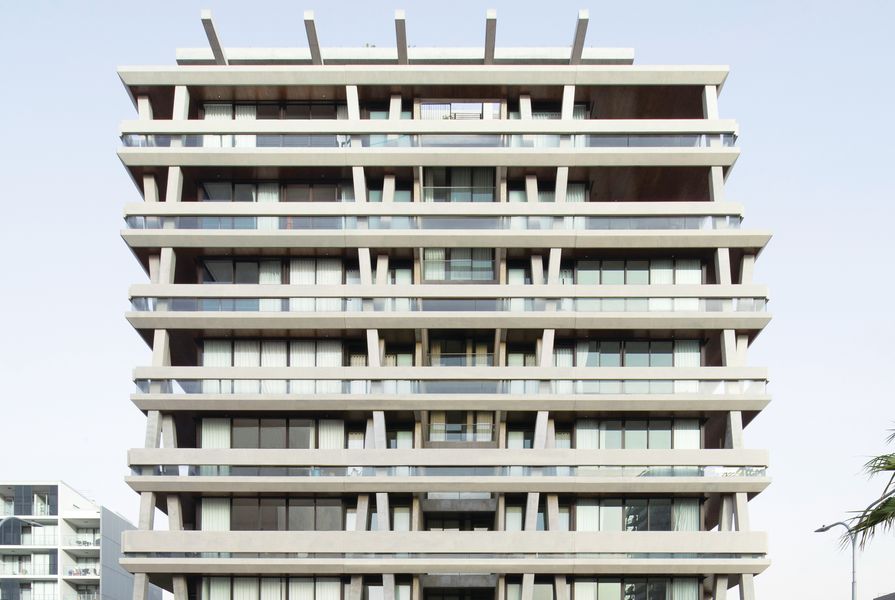Scale is an underappreciated element of urban housing. Housing must find its measure between the intimacy of the domestic realm, the intermediate community of its residents and its responsibility to make the city fabric itself. The elasticity of these scale conditions is demanding and powerful. Much of Sydney’s contemporary housing is a catalogue of misunderstanding, from the banal repetition of domestic micro-grids, the extraneous aluminium appendages or the even more reductive painted “supergraphic” through to my personal favourite, the stepped transitions at the top of buildings that scream, “Just pretend I’m not here!”
Waterloo Apartments by Chenchow Little, located in the Lachlan precinct of Sydney’s Green Square, is apparently known by locals as “the Rock.” This moniker likely stems from the structure’s emphatic raw-concrete character, but it also acknowledges the force that this building emanates through its scale response. Scale is not a rarefied form of architectural mysticism; people feel it bodily and measure their city by it. The building occupies an entire urban block, making the vertical face of Dyuralya Square to the north, anchoring the corner of Wulaba Park to the south-east, and holding key frontages on new civic boulevards : Gadigal Avenue to the west and Archibald Avenue to the south. It is emphatically in-the-round , and its urban attention is being pulled in multiple directions. Rather than scripting piecemeal responses to each orientation, the building firmly anchors itself in the urban fabric, obliging these diverse conditions to gravitate toward it. In doing so, it manages to inflect the hierarchy of the urban plan: the smallest element becomes a critical civic fulcrum.
Chenchow Little’s design perfectly articulates the shifting relationship between privacy and proximity in an urban context.
Image: John Gollings
The expressive potential of structure is commonly used in many building types, but less often in housing. Economics minimizes its role, strictly limiting its size and forcing it to be replicated consistently to coincide with the dimensions of the individual unit module. Typically, structure is held inside the building and concealed, or else it coalesces with separating and bounding construction. Its expressive potential is subsumed and gifted to the facade, which is tasked with articulating a relationship with the public realm.
In Waterloo Apartments, the structural module is completely independent of the unit module and, indeed, the building itself. It is pulled outside the skin of the building and multiplied, and its scale is inflated. Angled columns emerge from the earth, extending up through the full height of the building. On the eastern and western sides, the columns’ crossed profiles are revealed in elevation, while on the northern and southern sides, the spacing between each leg shifts dynamically as it intersects with horizontal balcony projections. The facade retreats deeply into these shaded, linear bands. The building’s expression is elemental and unapologetically tectonic.
Chenchow Little drew this structural language from the site’s history. The site is located on the old estuarine beds of the Waterloo Swamp , and the name of neighbouring Dyuralya Square references the Indigenous word for the brolga, a wetland bird. The architect’s analysis explored the structural tracery of wetland trees and stilt structures, documenting their densely thatched linear members and angled bracing.
Waterloo Apartments takes up an entire block, creating a vertical face for Dyuralya Square to its north and holding key frontages on new civic boulevards.
Image: Peter Bennetts
Founding the project narrative in this way was highly strategic. It carried enough to excite the requisite design competition jury and define a Design Excellence agenda without limiting opportunities for design evolution, and it astutely anticipated the restrictiveness of commercial construction in Australia. It was shrewd to anchor the building’s expression in something fundamental, such as structure, that cannot easily be deleted. That’s not to say that negotiation wasn’t required. Chenchow Little worked productively with subcontractors to find solutions to perceived difficulties such as the inclined columns, which used a standard concrete forming tube that allowed the diagonal structure to be poured without the need for expensive, bespoke formwork.
Chenchow Little then amplified the building’s vertical tectonic language with a perpendicular layer of horizontal elements. Again, the scale decision is primary, with each balustrade element formed of a series of precast concrete beams that articulate the full width of the urban block. The robust steel connections linking column to balustrade are more akin to infrastructure than architecture. In a beautifully judged understanding of the relationship of resident to passer-by, glazed bands within the balustrade beams increase in height from base to top, perfectly articulating the shifting relationship between privacy and proximity and incrementally diminishing the weight of these elements as they march toward the sky. A concrete diminuendo. The soffits – the primary surfaces glimpsed by upward-gazing pedestrians – are trimmed with the contrasting material presence of plywood so that the proportion of timber to concrete increases as you read the building from a position of more intimate adjacency.
The deeply recessed skin of Chenchow Little’s Waterloo Apartments building allows for genuine privacy alongside an entirely glazed facade.
Image: Benjamin Hosking
The split horizontals of the balcony detail also effortlessly transition a potentially awkward setback where the building shifts from six to eight storeys on its southern side. The transition sits seamlessly within the building’s overall tectonic logic: the built form retracts at the point of the paired bands, which retains the continuity of the horizontal line and allows one of the inclined column legs to be neatly terminated at the corresponding datum.
The planning of the apartments results in high levels of internal amenity, as should be expected on a site with such a generous proportion of street perimeter to footprint area. On the lower levels, living rooms occupy the prized dual-aspect corners, with two two-bedroom apartments on the southern side of the plan and four two-bedroom apartments touching the key northern face. Not content with the amenity offered by the available perimeter, the architects have further articulated the plan with deep insets in the centre of each street facade: the north–south slot facilitates entry and movement through the building at the ground plane and operable windows to some bathrooms above, while those on the eastern and western sides offer withdrawn, private windows to paired bedrooms. On the two upper floors , the plan shifts to accommodate four more generously sized three-bedroom apartments per floor.
It is in the most intimate human contact of resident to facade where perhaps there were missed opportunities to explore domestic intimacy through enclosure, rather than making an entirely glazed facade. The urban armature is so strong that there was ample room for variance without undermining its legibility. Even so, the decision to so deeply recess this skin offers genuine privacy and avoids the trap befalling many contemporary apartments where “back-of-curtains” becomes the dominant material expression.
The building is crowned with a roof terrace, the majority of which – save for a small area dedicated to the mechanical plant – offers a generous communal space for residents. The muscularity of the overhead structure provides a dense and satisfying sense of protection to what can be an oppressively hot and windswept experience at such heights. This overhead structure’s dramatic cantilever and repetitive, paired U-shaped concrete channels provide an emphatic termination to the building, a tertiary layer that completes the satisfying accumulation of civic mass.
The Waterloo Apartments are a resounding addition to the Lachlan precinct in Green Square, articulating their urban situation with a proficiency and confidence more commonly associated with public works. How satisfying it is to find a work of housing that greets the urban realm as its complement, unapologetically shaping the city with elemental strength rather than superfluous graphic gesture. The bravura of its framing of civic space leaves many of its urban counterparts feeling comparably “lightweight” indeed.
Credits
- Project
- Waterloo Apartments
- Architect
- Chenchow Little
Sydney, NSW, Australia
- Project Team
- Tony Chenchow, Stephanie Little, Ian Leung, Gerald Lau, Joshua Mulford, Jie Xie
- Consultants
-
Access consultant
Cheung Access
BCA consultant BCA Logic
Builder Grandmetro Constructions
Bulding Sustainability Index consultant GAT and Associates
Certifier Dix Gardner Group
Developer JQZ
Landscape architect McGregor Coxall
Model maker Kinkfab
Services engineer Norman Disney Young
Structural engineer JSBC Consulting
Town planner Urbis
- Aboriginal Nation
- Built on the land of the Gadigal people of the Eora nation
- Site Details
-
Location
Sydney,
NSW,
Australia
Site type Urban
- Project Details
-
Status
Built
Category Residential
Type Apartments, Multi-residential
Source

Project
Published online: 2 Nov 2020
Words:
Laura Harding
Images:
Benjamin Hosking,
John Gollings,
Peter Bennetts
Issue
Architecture Australia, May 2020
























